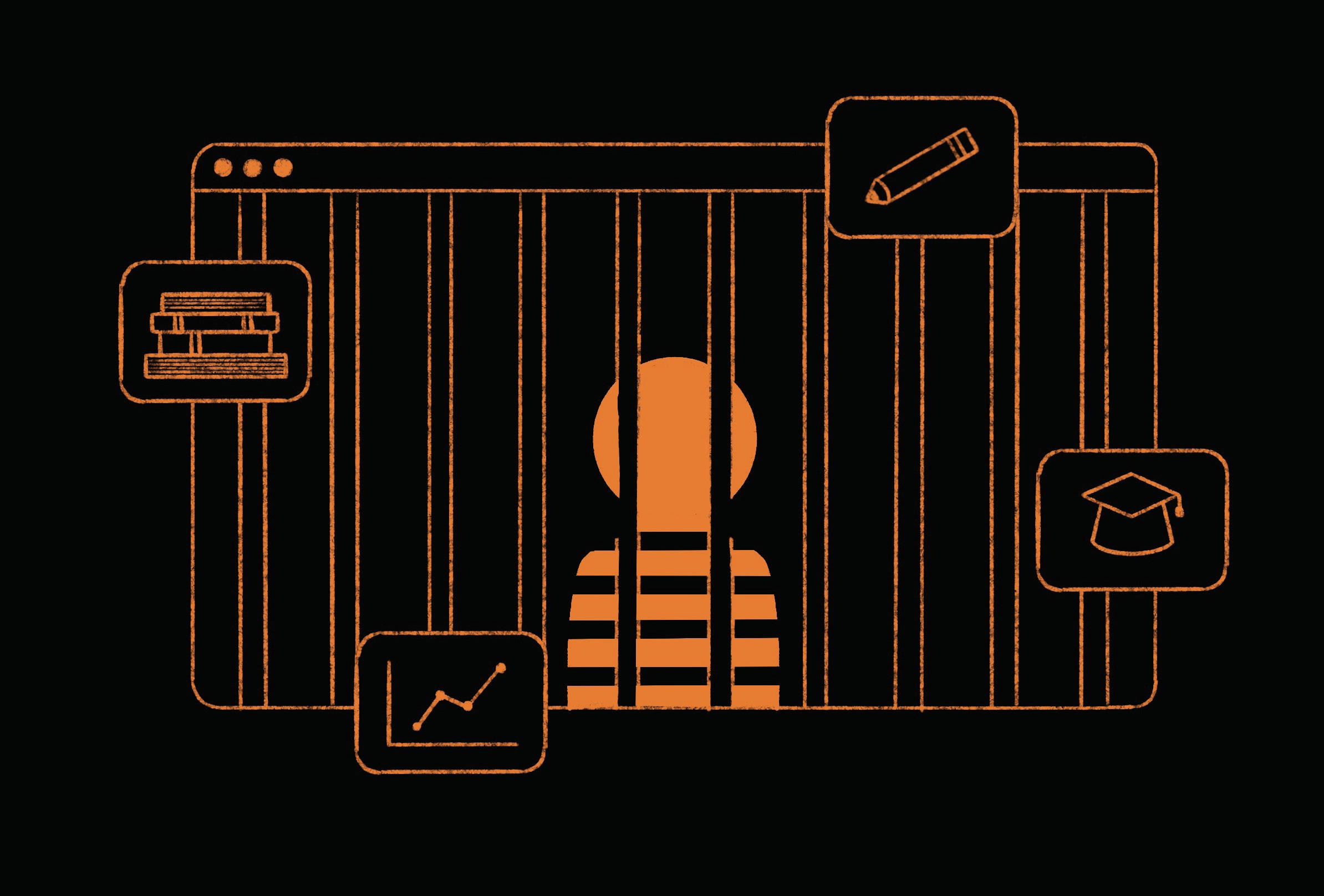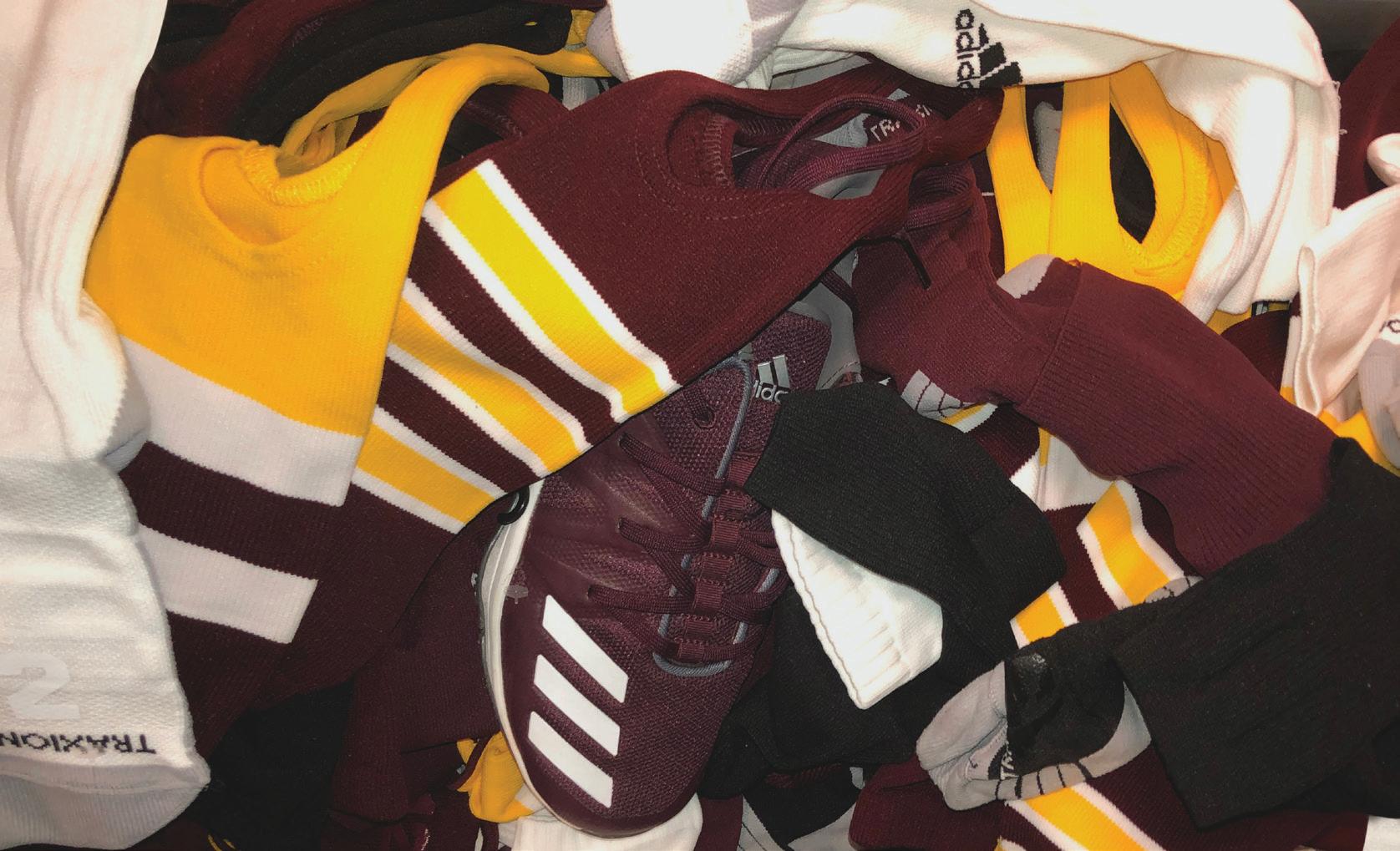
7 minute read
Feature: Education, detained
Education, detained
The coronavirus pandemic halted the only path some incarcerated individuals had to education
by Chase Hunter B.
Illustration by Nghi Tran
The end of ASU’s Inside Out prison program is usually marked with a graduation ceremony for incarcerated people, but the final in-person class in 2020 came and went before anyone knew it would be the last.
The COVID-19 pandemic forced Arizona Department of Corrections, Rehabilitation and Reentry officials to abruptly end in-person visits to prisons which curtailed ASU’s Prison Education Programming and the Inside-Out classroom. Since then, civil rights organizations like the ACLU and NAACP sued ADCRR — including at least three prisons involved in or seeking to be involved in ASU prison programs — for providing inadequate living conditions for inmates.
PEP and the Inside-Out classroom are two ASU initiatives bringing education to incarcerated people in Arizona prisons. The PEP offers a diverse set of classes for inmates to participate without credit. The InsideOut classroom, ran through ASU's School of Criminology and Criminal Justice, allows students to attend class with inmates once a week.
According to March 26 data from the COVID Prison Project, more than 1 in 4 incarcerated people have tested positive for COVID-19 out of 43,644 inmates tested. Arizona prisons have faced lawsuits from the ACLU and NAACP among other ongoing lawsuits concerning prison conditions.
Inmates in a Perryville prison did not have running water for a pair of days last summer. Labor practices at a Red Rock Correctional Facility in Eloy, Ariz. were alledged to reflect those of modern-day slavery by the NAACP. Another case by the ACLU, suing on behalf of defendants with “leukemia, kidney cancer, asthma, and high blood pressure,” alleged that a private prison in Florence, Ariz. was not complying with public health guidelines to protect incarcerated people from COVID-19.
But since in-person PEP ended after the spring semester, educators and former students of the class have had no contact with incarcerated people, said co-Director of PEP Naala Brewer.
“The only thing I can do is pray for them because there's nothing else really I can do.” Brewer said. “You're not allowed to ever contact them again. You just have to know you did the best you could while you were there.”
A shift to online interconnectivity
Cody Telep is the director of the InsideOut program at the School of Criminology and Criminal Justice. Once a week, he and students in the program would drive to Arizona State Prison Complex in Florence to attend class with inmates.
“We had our final class in the prison on March 4 and we really had no sense then that the class might be impacted by COVID,” Telep wrote in an email. “By Friday of Spring Break, the Arizona Department of Corrections announced they would be restricting visitation and volunteers from coming in for at least a month.”
By the following Monday, the tsunami of COVID-19 chaos continued to wash over the state, and ASU would hold on to the class through a lifeboat of virtual meetings for the rest of the semester.
“Inside-Out is definitely tough to adapt to a virtual learning environment,” Telep wrote, “as so much of the class depends on the in-person interactions between inside and outside students.”
Telep tried his best to continue the course by sending ADCRR printouts for class, including letters and updates from outside students, but it “definitely was not the same.”
Safety concerns for students at ASU and inside the prison derailed the Inside-Out program until Spring 2022. While ASU classes will be returning to in-person instruction this fall, Telep and the Inside Out program felt it was wise to hold off relaunching the program until all students, incarcerated or otherwise were vaccinated.
A dual purpose
It wouldn’t be the first time that a prison program was abruptly ended, albeit for very different reasons. Corri Wells, co-director of PEP, spearheaded the Pen Project, which abruptly ended when the English department cut the program in 2018, she said.
It came as “an accident” in a conversation with a graduate student during sessions of an English conference, she said. The student mentioned a professor named Joe Lockard who had just received a message from a woman in the Penitentiary of New Mexico in Sante Fe, Wells said.
“I was talking about wanting to be more involved in something that would filter out into real communities,” Wells said.
Wells founded the Pen Project at ASU in 2011; otherwise known as English 484. Interns in the project did not write to incarcerated individuals – “it’s not pen pals at all” – rather, they would go by pseudonyms and provide literary critique to inmates who wrote essays, poems and other pieces of writing for the class.
The Pen Project exploded.
PEP at the time when Wells was facilitating the Pen Project, had 8 classes in two prisons. When Wells became the director of PEP that rose to seven prisons and more than 30 different classes per semester.
But ASU’s education programs do more than just provide a learning environment for inmates.
“I think it gives them pride, but I think having contact with a responsible adult they may have never had that in their lifetime, who's consistent with them... that gives them something they can't get there,” Brewer said.
Brewer noted the “tense” relationship that
often exists between inmates and prison guards. But in the classroom, inmates have a chance to expand their intellectual curiosity. One inmate wrote a 300-page manuscript on investing.
“We allowed him to take the first hour of the class one semester to teach – I actually learned something from his investing class,” Brewer said.
Some students say the program helped them form a more compassionate view of incarcerated people and a more informed perspective on the prison system.
“I have a cousin. He’s been to jail. He’s a distant cousin,” wrote Samantha, a former participant of the class on the syllabus of the Spring 2019 course. “He is distant because we don’t really associate with that part of the family. Until now. Thanks to you.”
Without a goodbye
The English department ended the program in late 2018. Wells recalled the end of the Pen Project as the “greatest sadness of my time at ASU.”
The fate of the Pen Project became a preview for the other prison program initiatives at ASU when a once-in-a-generation pandemic spread through the United States in March 2020.
PEP has continued through the pandemic but program coordinators had to adapt. “The Arizona Department of Corrections really didn't want to start a new mail service,” Brewer said. “They didn't want to deliver our course materials and switch them back and forth.”
Lantern, “a watered-down version” of Canvas, available on tablets would allow ASU to continue its variety of courses. But Brewer is still in talks to establish this as an opportunity for incarcerated individuals.
Learning to adapt through Lantern has given Brewer hope for greater access to education for inmates in the future, she said. Even though in-person classes will be hampered for the foreseeable future and through the fall.
“We’re very hopeful that things will be more back to normal by then,” Telep said. “We plan to open up applications for the Spring class early in the Fall 2021 semester.”
A pestilential environment
Inmates are at the will of prison guards and the warden. And throughout the pandemic, prisons have been an epicenter for COVID-19 across the country, worsening the mistreatment of incarcerated people. "For months, public health officials and corrections experts have warned that under current circumstances, prisons and jails will become especially potent vectors for the rapid spread of COVID-19 inside the facilities and in the surrounding communities," said Emma Andersson in a press release, senior staff attorney with the ACLU's Criminal Law Reform Project.
Some prisons in Arizona have seen more than half their populations test positive for COVID-19. At the correctional facility in Florence, 12 inmates have been confirmed to have died from COVID-19 complications, according to March 18 statistics from the COVID Prison Project.
And in the Red Rock Correctional Center in Eloy, the NAACP sued ADCRR and private prison firms GEO Group, CoreCivic Inc. and Management and Training Corp for allegedly engaging in conduct amounting to slavery. This court case was dismissed by the U.S. District judge.
The ACLU sued Central Arizona Florence Correctional Complex for not complying to public health guidelines last May, including a lack of proper care for a 39-year-old woman with leukemia and 50-year-old woman with kidney cancer who were denied access to treatment for their conditions, according to the lawsuit.
ASU is working with both the prisons and third party education platforms to help inmates earn college credit through ASU classes while serving time. President Michael Crow has supported the effort, Brewer said, and they hope this can be an opportunity for inmates in the future.
“Part of doing prison education is you kind of have to detach and wear other people like a loose garment,” Brewer said, “because they're going to come and go and you have no control over it.”




